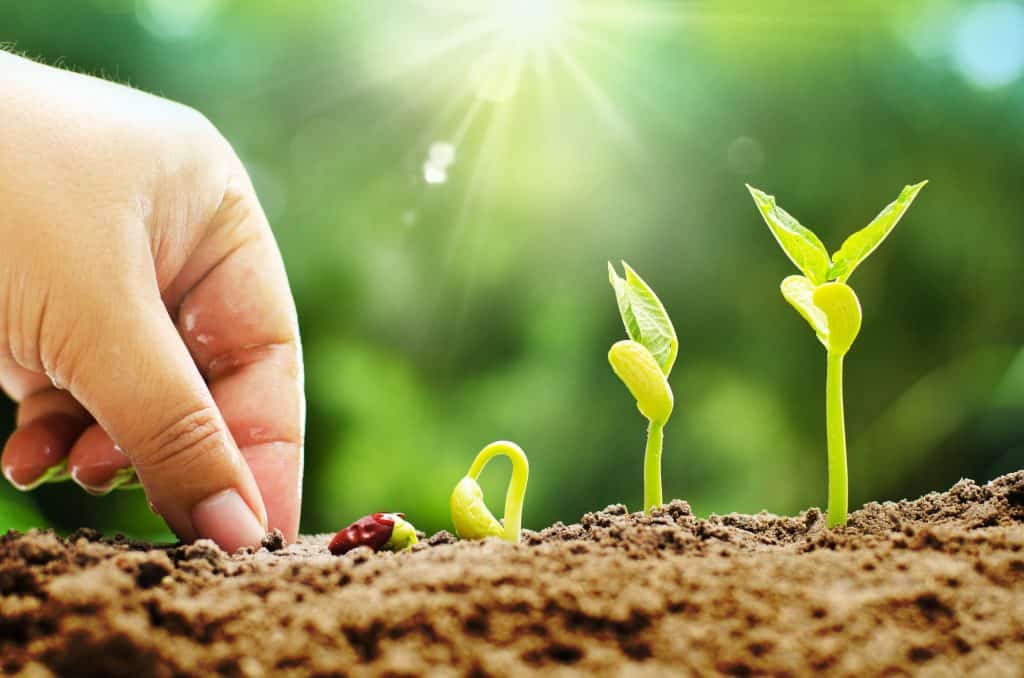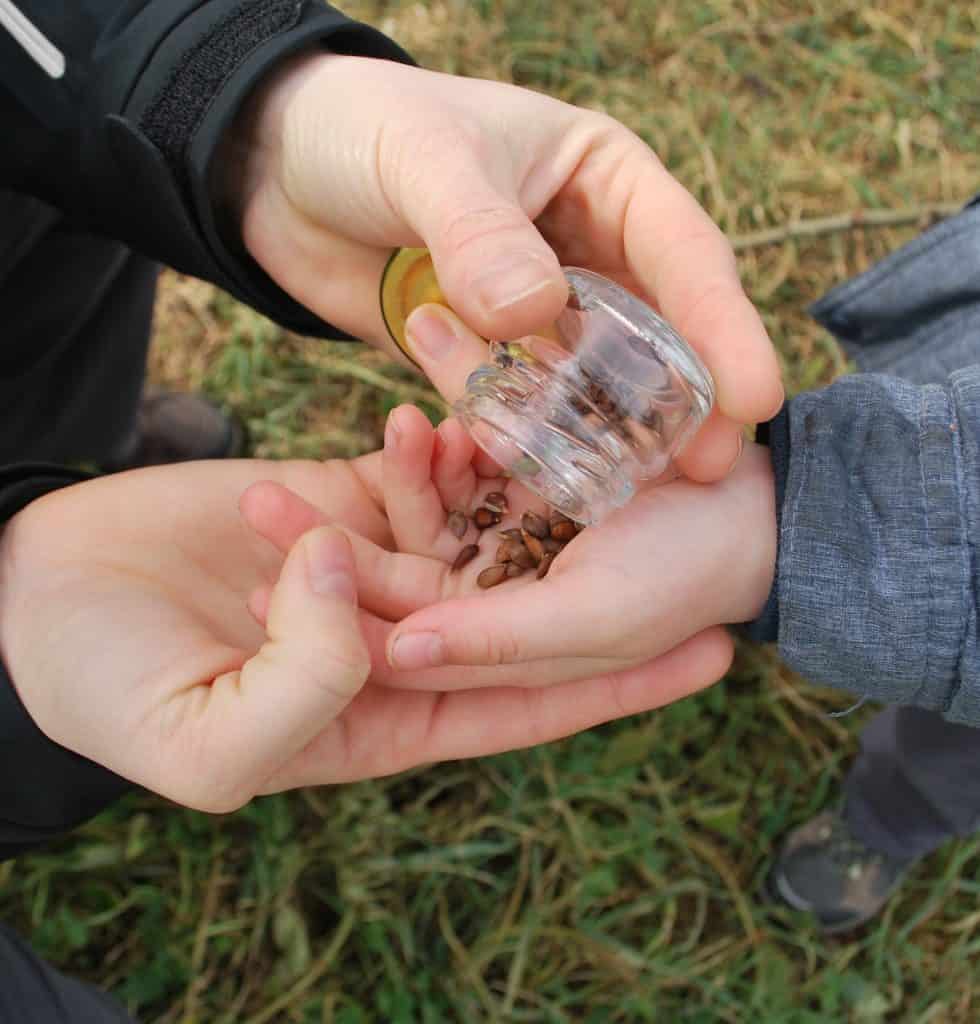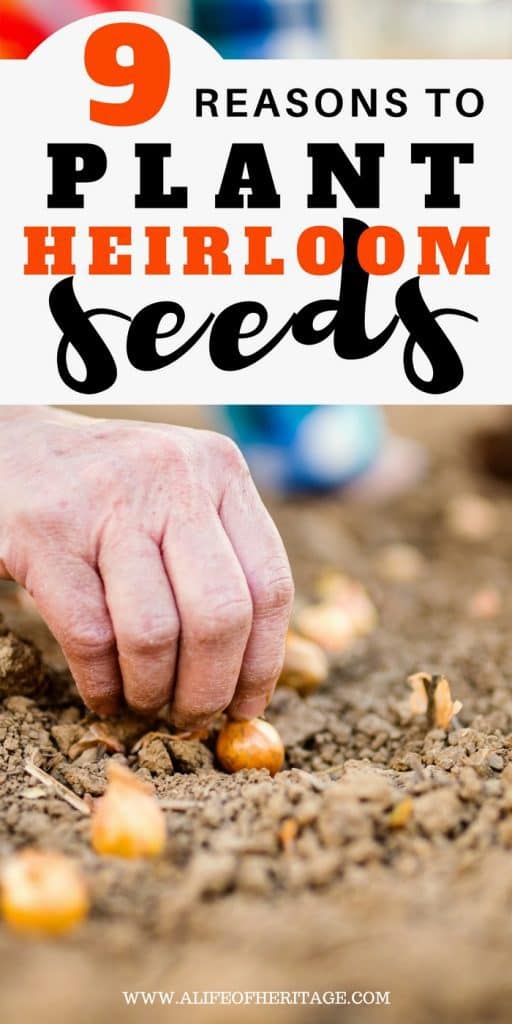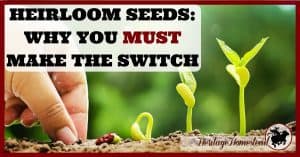Heirloom seeds are the key to our future.
There are several keys of course: bees, teaching our children how to grow and eat real food, learning how to effectively manage our gardens through no-till gardening, and knowing how to eliminate weeds by giving the soil what it’s crying out for.
But without seeds, none of this is effective or entirely impossible!
The food pushing up through the ground all over the world is the life and death of a seed. Which is quite marvelous. There is something mysterious and alluring about life resulting from death, isn’t there?
And heirloom seeds are, thankfully, making a comeback. Because the death of these seeds produces something special that other seeds can’t replicate.

“Heirloom seeds”, what’s all the hype?
Let’s break this down by first looking at what open-pollinated, organic, hybrid, and GMO really mean.
Open-Pollinated Seeds:
The seed can be harvested, saved, replanted and year after year the same variety of plants will grow.
Many new seeds today are not old enough to be considered an heirloom.
Heirloom seeds are open-pollinated but not all open-pollinated seeds are an heirloom.
Organic Seeds:
A certification process that assures that the plants grown meet all the regulations and requirements as set up by the USDA.
An organic crop means that it has been grown under a specific set of standards.
Hybrid Seeds:
A seed resulting in cross-pollinating two genetically different plants of the same species.
The cross-pollinating is done by hand and the seed will not grow true to either of the parent plants. You, as the gardener then, are forced to buy new seeds each year. Typically these are grown for commercial use because of their ability to produce higher yields, have better disease resistance, or higher uniformity.
Interestingly, this practice began in the 1920s and 1930s, when farmers needed more consistency with their yields to provide fresh produce to the locals in the 50-mile radius around their farms. But taste and flavor were still very important then. Now? Many of the varieties are tasteless and colorless.
GMO Seeds:
The seeds have been altered using DNA from completely different species and organisms to give different traits such as resistance to herbicides and acceptance of chemical fertilizers.

Now that we have those definitions in place, what does heirloom mean?
Heirloom: “something of value (possession or otherwise) passed down from generation to generation. Noting or relating to an old plant variety that is being cultivated again.”
An heirloom seed has been carefully selected because of its value. Perhaps its excellent flavor, hardiness, strength, adaptability, or productivity were deciding factors in the decision to carefully save the seed for the next planting year.
Any weak or diseased plant does not make the cut and, of course, those seeds are not passed down. So, heirloom seeds leave us with the very best!
And isn’t it cool to think that there are many heirloom seeds that have now been passed down for 100 years? And some varieties are even as old as 300 or more years! Oh, the stories they could tell!
What are the benefits of using heirloom seeds? Why should you make the switch?
There are quite a few reasons! Here they are:
• Very adaptable
• Known to adapt to a specific location within as little as 2 to 3 growing seasons and because of this they will:
• Show better vigor
• Have better production
• And have increased disease resistance
• Oodles of flavor
• And if the flavor isn’t the point of our food, then I don’t know what is!
• Shown to have more nutrition
• Less uniform
• Most likely they will ripen at different intervals and won’t leave you with a mound of tomatoes to deal with all at once. It’s a gradual supply all summer long.
• Overall they are less expensive
• After the first planting, most seeds can be saved for the following year, therefore saving on the cost of seeds in the years to come.
• You will be playing a big part in preserving the genetic diversity of the plants you are growing and can begin to pass down those seeds saved to the generations after you. How fun is that?
These are the results of planting, saving, and replanting heirloom seeds year after year.
Let’s go back and think about the “overall they are less expensive” point.
Have you ever looked at a box set of heirloom seeds and swallowed hard when you looked at the price? Yup, it’s easy to feel that way, especially if you run on a tight budget anyway. It can feel like you’re squeezing the last drop out of every penny. (You may be interested in 230 ways to earn income on your property.)
I get it, seeds can get expensive. But I did a bit of legwork to show you the reality of what seeds cost, even the “cheaper” hybrid seeds. You may be surprised.
The chart below shows the difference in prices of heirloom seeds and seeds from two other well-known companies. Do you have a favorite seed company or catalog? Take some time to figure out what it would cost you to purchase the seeds below. You can fill in the last column and it will total up the numbers for you!
If the chart below does not load, please use the link to view: Cost of Heirloom Seeds vs Hybrid Seeds
That really puts into perspective how precious and costly seeds can be! But when you think about it, seeds are the key to your future. And it’s the heirloom seeds that will get us to that future.
There is an art to growing our own food. If you feel like you aren’t creative or “artsy”, think again. When spring rolls around every year, it’s time to plan a no-till garden (hint, hint!), how all of the plants (and don’t forget the flowers!) will be planted together and arranged, and man! I gotta tell you, there is an art and beauty to the canning process!
But you have to start with the seeds. What will you plant? Which ones need to be started indoors? How will they be preserved after the harvest? And how will the seeds be saved?
It’s a lot to think about and plan for. But when you have a seed kit where all the seeds are in individual, resealable Mylar foil bags, and in a bucket with a tight closing lid that can keep seeds fresh for up to ten years stored under the proper conditions, you really can get that garden of yours in gear!
After all, it’s only your future!
Start planning now!
And of course, you don’t want to miss out on our FREE resource page. It has oodles of good flavor…information…as well! Check it out below:
FREE resource page for homesteaders, gardeners, and those who love self-sufficiency
FREE RESOURCE PAGE
There is always so much more information to learn about heirloom seeds. More reading below:
Hybrid vs Heirloom


Fancy Plants Nursery
Tuesday 19th of March 2019
Excellent explanation, it’s simple & focused
Delci Plouffe
Friday 29th of March 2019
Thank you :)